|
|
Rugged tablets the perfect tool for Taiwan's utility workers
With the growing popularity of the form factor, tablets can increase productivity in the power utility industry. If they are tough and rugged enough for the job.
Even more so than laptops, tablet computers can be used anywhere, anytime. And with tens of millions of people now familiar with the tablet form factor with their smartphones and iPads, they expect the same functionality and ease of use in the computing equipment on their jobs. As a result, tablets are increasingly used in the field as well. Case in point: the utility industry in Taiwan (where most of the world's tablets are made).
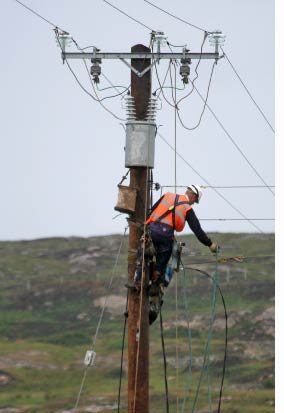 With an impressive installed capacity of 41 GWe and a net consumption of 207 billion kilowatthours (2008 figures), Taiwan is among the world's top top 20 electricity producers and consumers, though in terms of population the nation barely makes the top 50 (approximately 23 million) and by land area it is not even in the top 100. That means a very dense power grid and infrastructure. With an impressive installed capacity of 41 GWe and a net consumption of 207 billion kilowatthours (2008 figures), Taiwan is among the world's top top 20 electricity producers and consumers, though in terms of population the nation barely makes the top 50 (approximately 23 million) and by land area it is not even in the top 100. That means a very dense power grid and infrastructure.
As is the case in most modern industrialized nations, Taiwan's electrification is virtually 100%, no small accomplishment given that the eastern two-thirds of the nation consist mostly of mountain ranges soaring as high as 13,000 feet. The Chianan Plains in the west, on the other hand, are densely developed and home to most of Taiwan's population.
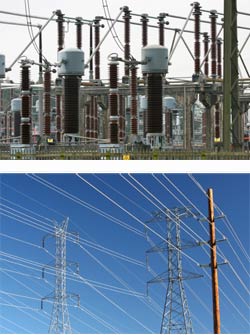 What this means is that Taipower and Taiwan's independent power producers are exceedingly busy maintaining the electric grid both in urban as well as in rural and mountainous areas. These utility workers rely not only on training, experience and expertise to keep the power going, but also on modern tools to do their job. This is where rugged tablet computers come in. What this means is that Taipower and Taiwan's independent power producers are exceedingly busy maintaining the electric grid both in urban as well as in rural and mountainous areas. These utility workers rely not only on training, experience and expertise to keep the power going, but also on modern tools to do their job. This is where rugged tablet computers come in.
While laptops continue to be useful and required in numerous applications, tablets are often handier in the field. They are smaller and lighter, can be used while walking around or performing a task, and their touch screen make them suitable for quick and easy operation.
Standard consumer media tablets, however, are not designed and built to survive in the field where they may get dropped, soiled, or rained on. In order for a tablet to be useful in the field, it must not only provide computing and communications functionality, it must also as tough and durable as any other tool on a field worker's job. In order to make power utilities field personnel's assignments easier and productive, a tablet computer must:
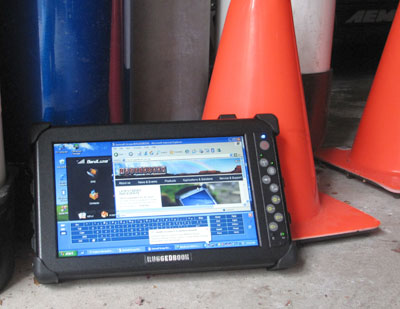
- Be small and light enough to be carried around on the job without interfering with daily work and assignments.
- Have a touch screen that remains visible and readable even in direct sunlight, and is large enough to be easily viewed and used.
- Have all the required communications features (WiFi, WWLAN, Bluetooth, etc.) to reliably facilitate instant communication, lookups, data capture and data tracking.
- Offer reliable, accurate GPS functionality for locating power poles, switch boxes and customer installations in any geographic environment.
- Be built to withstand drops, vibration, temperature extremes as well as dust and water and other environmental as outlined in MIL-STD-810G testing procedures.
The picture above shows a Samwell RUGGEDBOOK SR820 tablet computer with a 8.9-inch daylight-readable display that is large enough to show a wealth of information (including large GPS maps), but not too large to slow a utility worker down or confine the device to be used in a vehicle or field office. IP65 sealing means the unit is largely immune to dust, rain and weather, and the device has passed numerous environmental tests, including shock and vibration.
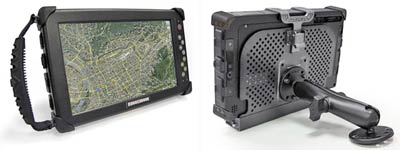 The Samwell RUGGEDBOOK SR820 provides Windows functionalty and performance in a rugged tablet form factor. Measuring just 10.1 x 6.2 x 1.5 inches and weighing under three pounds, the SR820 is smaller and lighter than full-size rugged tablets without requiring many compromises. There is good wired connectivity on board, all the connectors are standard size, and there is a wealth of wireless functionality (including available GPS and 3.75G radio) and also an integrated camera and optional laser scanner. The device can easily be carried and just as easily mounted in vehicles (see pictures above). The Samwell RUGGEDBOOK SR820 provides Windows functionalty and performance in a rugged tablet form factor. Measuring just 10.1 x 6.2 x 1.5 inches and weighing under three pounds, the SR820 is smaller and lighter than full-size rugged tablets without requiring many compromises. There is good wired connectivity on board, all the connectors are standard size, and there is a wealth of wireless functionality (including available GPS and 3.75G radio) and also an integrated camera and optional laser scanner. The device can easily be carried and just as easily mounted in vehicles (see pictures above).
Relevant Information:
Samwell Group RUGGEDBOOK SR820 page
To learn more about the ruggedized Samwell SR820 tablet computer and its many applications, email RUGGEDBOOK at info@ruggedbook.com.tw. And check RuggedPCReview.com's full analysis of the SR820.
RUGGEDBOOK Headquarters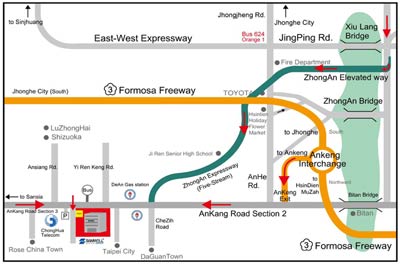
Samwell Building
317-1, Sec. 2,
AnKang Rd., Xindian Dist.
New Taipei City 23153, Taiwan (R.O.C.)
Telephone: 886-2-2214-1133
Fax: 886-2-2215-5458
Web: www.ruggedbook.com.tw
info@ruggedbook.com.tw
|





 With an impressive installed capacity of 41 GWe and a net consumption of 207 billion kilowatthours (2008 figures), Taiwan is among the world's top top 20 electricity producers and consumers, though in terms of population the nation barely makes the top 50 (approximately 23 million) and by land area it is not even in the top 100. That means a very dense power grid and infrastructure.
With an impressive installed capacity of 41 GWe and a net consumption of 207 billion kilowatthours (2008 figures), Taiwan is among the world's top top 20 electricity producers and consumers, though in terms of population the nation barely makes the top 50 (approximately 23 million) and by land area it is not even in the top 100. That means a very dense power grid and infrastructure.
 What this means is that Taipower and Taiwan's independent power producers are exceedingly busy maintaining the electric grid both in urban as well as in rural and mountainous areas. These utility workers rely not only on training, experience and expertise to keep the power going, but also on modern tools to do their job. This is where rugged tablet computers come in.
What this means is that Taipower and Taiwan's independent power producers are exceedingly busy maintaining the electric grid both in urban as well as in rural and mountainous areas. These utility workers rely not only on training, experience and expertise to keep the power going, but also on modern tools to do their job. This is where rugged tablet computers come in.

 The Samwell RUGGEDBOOK SR820 provides Windows functionalty and performance in a rugged tablet form factor. Measuring just 10.1 x 6.2 x 1.5 inches and weighing under three pounds, the SR820 is smaller and lighter than full-size rugged tablets without requiring many compromises. There is good wired connectivity on board, all the connectors are standard size, and there is a wealth of wireless functionality (including available GPS and 3.75G radio) and also an integrated camera and optional laser scanner. The device can easily be carried and just as easily mounted in vehicles (see pictures above).
The Samwell RUGGEDBOOK SR820 provides Windows functionalty and performance in a rugged tablet form factor. Measuring just 10.1 x 6.2 x 1.5 inches and weighing under three pounds, the SR820 is smaller and lighter than full-size rugged tablets without requiring many compromises. There is good wired connectivity on board, all the connectors are standard size, and there is a wealth of wireless functionality (including available GPS and 3.75G radio) and also an integrated camera and optional laser scanner. The device can easily be carried and just as easily mounted in vehicles (see pictures above).
